Pacific/Marmorata Mole Crab, Hippa marmorata
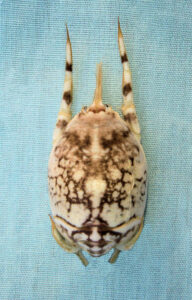
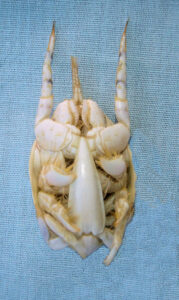 Marmorata Mole Crab, Hippa marmorata, Male. Collected by hand off the beach at Cabo Real, Km 21, Baja California Sur, November 2006. Size: 3.0 cm (1.2 inches) x 2.1 cm (0.8 inches). Identification courtesy of Dr. Claudia Jeannette Perez Estrada, Centro de Investigaciones Biológicas del Noroeste S.C., La Paz, Baja California Sur.
Marmorata Mole Crab, Hippa marmorata, Male. Collected by hand off the beach at Cabo Real, Km 21, Baja California Sur, November 2006. Size: 3.0 cm (1.2 inches) x 2.1 cm (0.8 inches). Identification courtesy of Dr. Claudia Jeannette Perez Estrada, Centro de Investigaciones Biológicas del Noroeste S.C., La Paz, Baja California Sur.
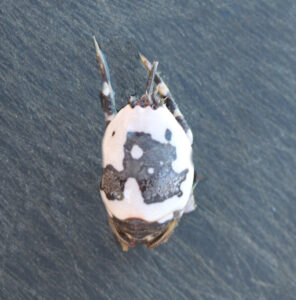 Marmorata Mole Crab, Hippa marmorata, Male. Collected by hand off the beach at Agua Verde, Baja California Sur, March 2020. Collection and photograph courtesy of Barry Mastro, Escondido, California.
Marmorata Mole Crab, Hippa marmorata, Male. Collected by hand off the beach at Agua Verde, Baja California Sur, March 2020. Collection and photograph courtesy of Barry Mastro, Escondido, California.
Reference Text Information: Dr. Claudia is interested in helping and supporting our effort. She asked me to chase mole crabs in CSL and keep her involved with the inventory. I have seen very few since that request came in over a year ago.
Some confusion here – Bertsch, below, calls this the Pacific Mole Crab. My guess is the Claudia is a better reference person. I can contact her as needed.
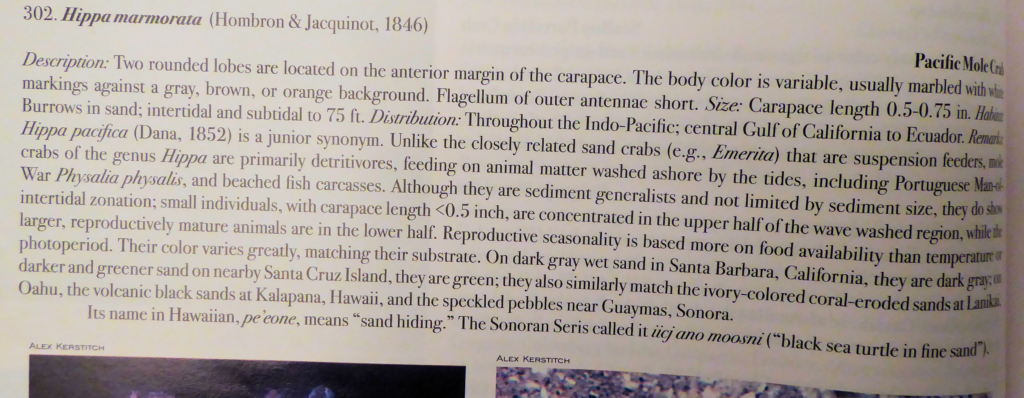
Spanish name – Cangrejo Topo del Pacifico per Bertsch.
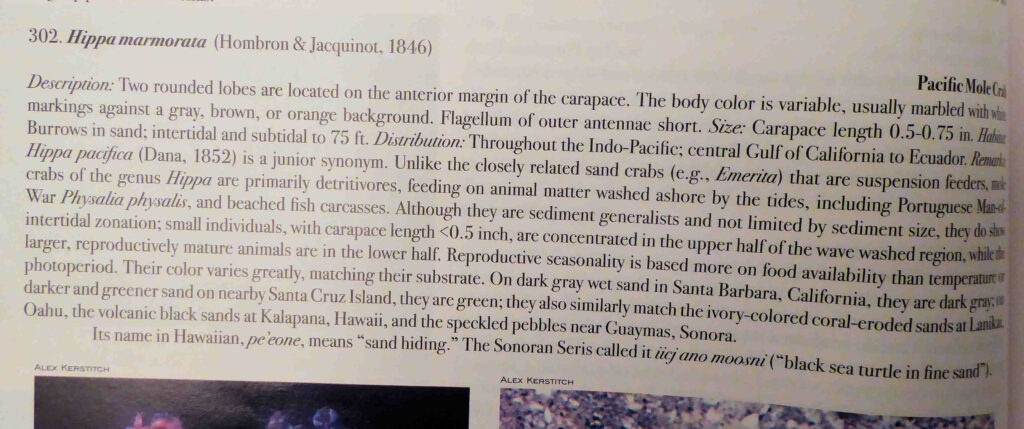
I don’t think we have this one?
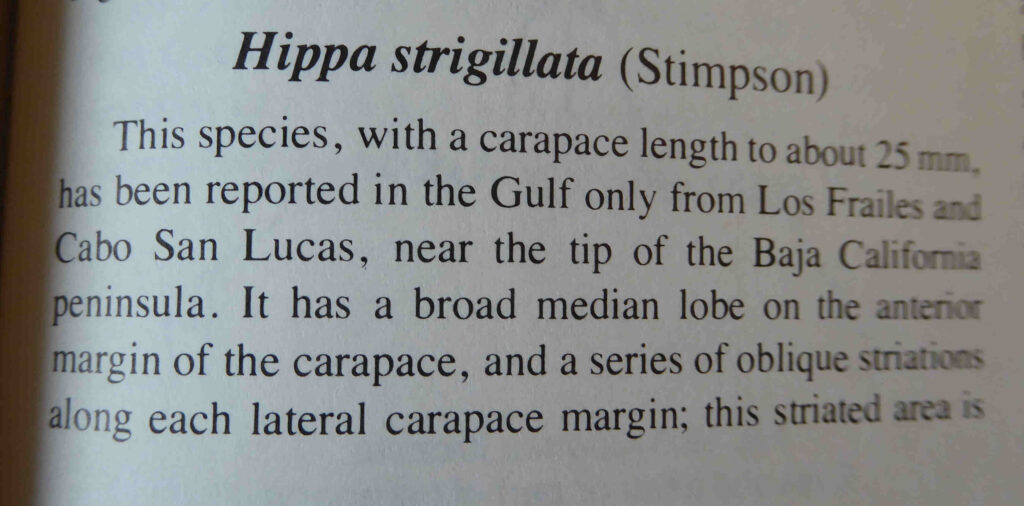

The Marmorata Mole Crab, Hippa marmorata, is one of five Mole Crabs found in Mexican waters, all belonging to the Hippidae Family, which are collectively known in Mexico as muy-muy cochitos. It is known locally as cochito rayado. The Hippidae Family has two genera the Emerita Genus and the Hippa Genus. Interestingly they reproduce based on food availability and not on seasonal, tidal or water temperature changes. They are a favorite live bait of the Southern California surf fisherman but not utilized frequently as bait in Mexico.
Members of the Emerita Genus have a strongly convex oval shell (carapace) that covers the legs, front legs (nonchelated) are without claws, back legs (telson) resemble paddles, they have long slender antenna and long slender eye stalks. Members of the Hippa Genus have a similar carapace, but the front and back legs are slender and pointed, they have short stubby antenna and short stubby eye stalks.
The Mole Crabs reside in sifting sand on wave-swept beaches in areas washed by waves and are very adaptable to conditions of heavy surf and strong currents. They bury themselves near the surface, facing seaward, with only their antennae and eyes out of the sand.
They collect floating debris, as waves drain off the beach, with their first pair of legs which is then transferred to their mouths.
In some locations they are fairly abundant but difficult to observe because they blend into the background extremely well.
The Marmorata Mole Crab is characterized by a wide and flat carapace with their submarginal comprised of 20 to 40 rows. Their carapace has transverse grooves and is cream colored. They are sexually dimorphic with the females being uniformly colored and the males having patterns. The shell is colored such that they blend into the substrate. They have two short antennules with two median lobes. Their dactyl is obtuse and not acute.
The Marmorata Mole Crab is found within intertidal areas within mud and sand substrate. They reach a maximum length of just over 2.5 cm (1.0 inch). and can be found at depths up to 60 m (200 feet). The Marmorata Mole Crab has been poorly studied and very limited information about their behavioral patterns and biology has been documented.
The Marmorata Mole Crab can be easily confused with the Coldwater Mole Crab, Emerita analoga(differently shaped feet, lines across the back half of the carapace), the Pacific Mole Crab, Hippa pacifica (two small lobes at the top of the shell between the eyes, no lines on the carapace), and the Striated Moles Crab, Hippa strigillata (lines that cover the sides of the carapace and the complete abdomen; one small lobe on the top of the shell between the eyes), and the Tropical Mole Crab, Emerita rathbunae (lines completely covering the carapace).
The Marmorata Mole Crab is found in the Pacific Ocean along the entire west coast of Mexico.
From a conservation perspective the Marmorata Mole Crab is small in stature and of limited interest to most. They are utilized by local surf fishermen on a limited basis as a live bait.